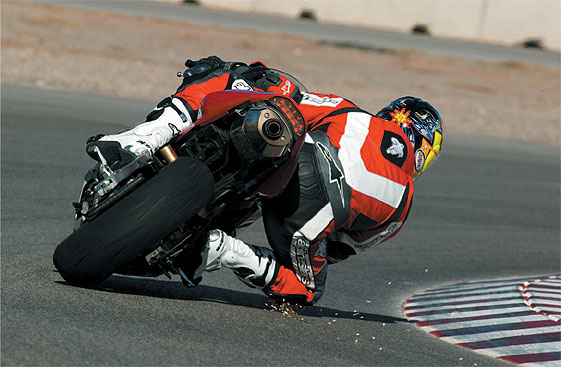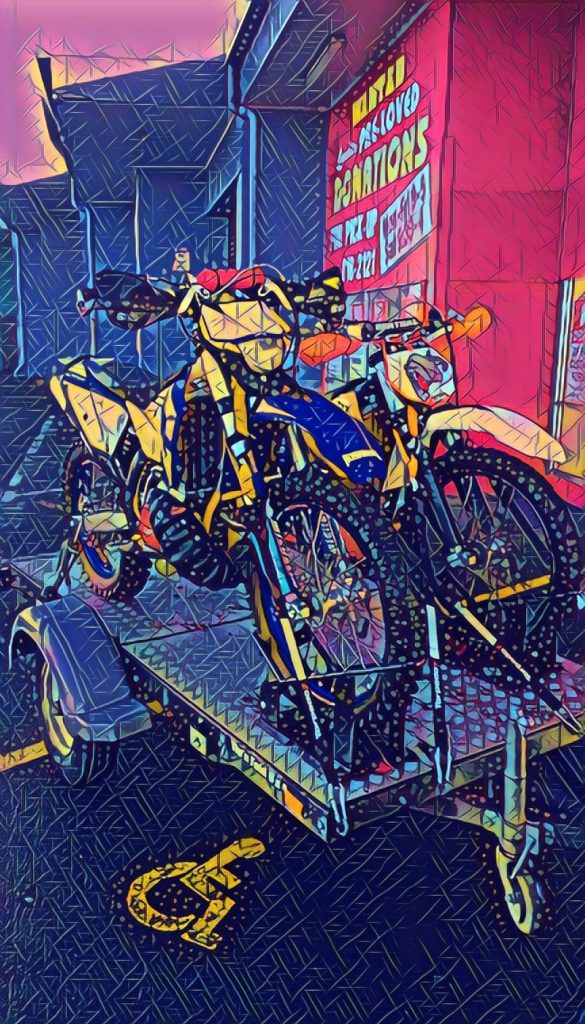
The Touch Points
Given how badly we handle compared to the bike. Do I need to remind you of the image most of us have seen when a bike gets stable AFTER the rider falls off :-). Strategies for controlling our movements and making sure we are as stable as possible are a good thing.
Touch points are exactly this. It’s not some sort of Friday night pervert scoring system.
When you are sitting on a bike, riding down the road you actually do need to hold onto it or you would fall off. So somewhere along the way we need to hold on without using the controls to hold onto and therefore doing control inputs that we shouldn’t be doing.
When we are hanging off the side in a corner this becomes even more important. Again we don’t want to be hanging onto the bars and swaying around on the pegs or swinging back and forth on the bike.
To do this we use touch points. We use touch points for a very important reason. We don’t want to have to think about it each time we move from one Set to another. We want it to become automatic, repeatable and allow our little brains to focus on other stuff.
Touch points for every rider will be different and you need to “design” the ones that work for you and also for the particular bike you are riding.
What is meant by touch points is the points that your body engages with (touches) the bike. There are some guidelines here of course. Such as don’t make your touch points controls (like handlebars), the one exception to this perhaps are the foot pegs (yes I consider them controls) as they can be very powerful touch points and allow positive control at the same time.
Positive control is a control action that creates, instigates or encourages a Set.
The main body of the bike, tank, seat, sides etc are the best touch point locations. The specifics of where are about the shape of you, what you are doing and the shape of the bike mostly.
To give you an idea lets talk about some of my touch points… Ok mind back on the bike riding guys!!!
Acceleration Set
When I am in an acceleration Set my touch points are, bum on seat, inside legs gripping tank, if possible with tank shape knees under tank, Feet are very lightly on pegs and able to move. If I am leaning forward and my “grip” on the bike is pivoted around my hips.
Now if I am on the track this goes further. My chest will be either on the tank or very close, my arms will grip the side of the tank and my forearms will be parallel to the road or even lower to stop me holding onto the bars, my feet will be pointing down to allow me to use the pegs as a point to “push” my body forward.
This allows me to become part of the bike and move as one with it as it accelerates and allow the bike to do its thing. It also allows me to keep my upper arms and in particular my throttle hand relaxed and “feeling” the acceleration I can get away with .
Braking Set
In my Braking set I am in one of two positions. I’ll use the least obvious as an example and the one I use personally when braking for a corner, as opposed to one I would use for a sweeper where I don’t need to change my seating position as much.
In my transition, the moment I roll off the throttle and the bike begins its transition phase I will move my body off the bike and get into a position ready for the corner. I will effectively be “hanging off” the bike but not quite. I do this so that my transition from braking to cornering is quicker and less upsetting for the bike.
The position I take up puts my inside toe on the foot peg and my inside knee turned into the motorbike and pushing toward the outside of what the corner will be (remember I am in the straight braking zone). My outside leg has its heel on the peg and toe turned out, the knee is bent over the seat and pulling against the inside knee to “squeeze” the bike between them. My groin and hips are forced up against the petrol tank and I am using the back muscles to hold up my upper body (along with a slight down pressure on my inside knee). My arms are relaxed and my upper body held “mostly” directly above the bike.
These touch points allow me to be half way to the corner touch points whilst at the same time being very stable and “locked” onto the bike to resist the braking forces while at the same time stopping me from using the bars for this purpose and allow me to still “feel” the brakes and the front of the bike to move as it needs to be (not becoming a Newtonian bridge).
Corner Set
Now let me first discuss how my transition works from Braking Set to Corner Set.
Seeing as I am pretty much already there from a body position point of view all I need to do is the following. Release the brake, counter steer to dial in the angle of dangle, roll my inside knee out pivoting on the foot peg and putting all my weight through that, move my upper body across and down into the turn. Done, smooth and fast.
As I move my upper body down and across the “lean” my outside arm against the tank to keep my upper body stable, and often push my inside elbow down into my inside knee so that I am braced.
Corner Set done.
The Set
I’m guessing by now you really have a good handle on what a “set” is but just to make sure let me describe it out for you.
A “Set” is analogous to setting a lump of concrete like jelly. When it is soft and floppy every bump, every input makes it wobble back and forth and behave, well like Jelly. When it has set its solid and it would take a lot of input to upset it. Getting a set on a bike is the same thing.
Suspension compresses and stays evenly compressed during the set, tyres distorts into the Set and keeps that shape, bike leans etc to match and stays there. Stability and the encouragement of this is the key to a Set and being smooth.



